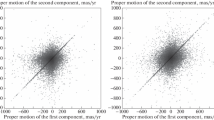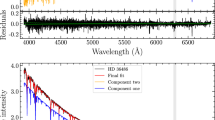Summary
We studied samples from theBright Star Catalogue of B1-B7, F3-G2, and KM dwarfs for frequencies of visual companions and their separations. The frequency of detected companions does not vary significantly along the Main Sequence. But the most frequent separations and the limiting separations vary markedly along the main sequence: the limiting separations are 42000 AU for the B stars to 800 AU for the M dwarfs. This confirms results found by Öpik in 1924. Stars off the Main Sequence (giants, white dwarfs) show consistent results, as do membres of Trapezium systems, hierarchical multiple-star systems, the widest known cataloged binaries, and binaries in a moving cluster (Ursa Major Stream).
We propose a scenario in which binaries in open clusters can have large separations, but after they leave the cluster environments, chance encounters with field stars and molecular clouds will disrupt all but the more compact systems. The comoving pairs discussed by Luyten, Eggen, and others are seen as members of disrupting clusters and still retaining the common cluster motions. However, the velocity dispersions within clusters ensure that the comoving pairs have similar, but not identical, motions, whereas members of truly bound binaries would have motions that are indistinguishable. Appropriate measurements should distinguish between wide binaries and the comoving pairs, which can have separations up to the outer diameters or more of open clusters.
Similar content being viewed by others
References
Abt, H. A.: 1986,Astrophys. J. 304, 688.
Aitken, R. G.: 1932,New General Catalogue of Double Stars Within 120° of the North Pole, Carnegie Institution of Washington, Publ. No. 417.
Ambartsumian, V. A.: 1954,Byurakan Ap. Obs. Contr. 15, 1.
Eggen, O. J.: 1950,Astrophys. J. 111, 414.
Eggen, O. J.: 1965, in A. Blaauw and M. Schmidt (eds.),Stars and Stellar System. V. Galactic Structure, Chicago Univ. Press, Chicago, p. 111.
Eggen, O. J.: 1986,Astron. J. 92, 125.
Greenstein, J. L.: 1986,Astron. J. 92, 859, 867.
Heggie, D. L.: 1975,Monthly Notices Roy. Astron. Soc. 173, 729.
Heggie, D. L.: 1977,Rev. Mexicana Astron. Astrophys. 3, 169.
Hoffleit, D. and Jaschek, C.: 1982,The Bright Star Catalogue, 4th rev. ed., Yale Univ. Press, New Haven.
Keenan, P. C. and Pitts, R. E.: 1980,Astrophys. J. Suppl. 42, 541.
Kuiper, G. P.: 1935,Publ. Astron. Soc. Pacific 47, 15, 121.
Lü, P. K. and Upgren, A. R.: 1973,Astrophys. J. 180, 91.
Luyten, W. J.: 1987,Astrophys. Space Sci. 142, 17 (this issue).
Mathieu, R. D., Latham, D. W., Griffin, R. F., and Gunn, J. E.: 1986,Astron. J. 92, 1100.
Öpik, E.: 1924,Publ. Tartu Univ. Obs. 25, No. 6.
Retterer, J. M. and King, I. R.: 1982,Astrophys. J. 254, 214.
Roman, N. G.: 1949,Astrophys. J. 110, 205.
Vandervoort, P. O.: 1968,Astrophys. J. 152, 895.
Author information
Authors and Affiliations
Rights and permissions
About this article
Cite this article
Abt, H.A. Visual binary separations as functions of primary types, ages, and locations. Astrophys Space Sci 142, 111–121 (1988). https://doi.org/10.1007/BF00656191
Issue Date:
DOI: https://doi.org/10.1007/BF00656191




